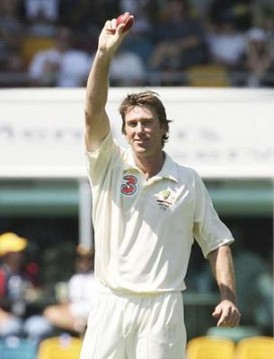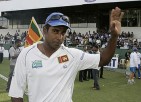The Rise and Rise of Australia – Part Two
Richard Dickinson |
A few days ago we begun a look at Australia’s Test team between 1989 and 2006/07, a period in which they were exceptionally rarely bettered and often untouchable. This is the conclusion of that feature.
For a whole year between June 1993 and March 1994, the batting was composed of Mark Taylor, Michael Slater, David Boon, Mark Waugh, Allan Border, Stephen Waugh and Ian Healy. With none even looking like losing form in this time (all averaged 44 or more), and all being players who had long and distinguished careers (Slater, with a mere 74, was the only one who did not notch a century of caps), whatever stage they were at at the time, it would be possible to argue that this was the strongest batting unit Australia put out all period. England were beaten emphatically away, and New Zealand at home were vanquished with similar contemptuous ease. The South Africans, however, provided a stern challenge in the first series between the two for 24 years, and the legs in both countries were drawn 1-1. The bowling remained a worry to some extent: Merv Hughes’ career was effectively ended after the England tour by a serious knee injury, and his replacement Glenn McGrath left plenty to be desired in his opening season, perhaps not terribly surprisingly given he had barely been in the First-Class game for five minutes when picked. Paul Reiffel, like his predecessors Geoff Lawson, Craig McDermott and Bruce Reid, was highly injury-prone. Shane Warne’s excellence, however, meant that the problems were nowhere near so considerable as they might otherwise have been.
Border’s retirement, coupled with the decline of Boon, meant that from 1994/95 to 1997/98 holes in the batting were not uncommon. Slater too dropped-out for a time, though his place was ably filled by Matthew Elliott. Future pillars Justin Langer and Matthew Hayden, however, struggled badly in their few outings; Michael Bevan could not transfer his sensational domestic form to Test level; and Greg Blewett and another future pillar Ricky Ponting were inconsistent enough to be dropped and recalled several times. However, the bowling was now going from strength to strength. McGrath quickly got the hang of Test cricket in 1995 after his premature elevation; Warne’s brilliance continued; McDermott remained excellent until his exit from the side; and Reiffel and two other new recruits, Damien Fleming and Jason Gillespie, provided excellent backup when they were fit (which was admittedly not often). Michael Kasprowicz had his moments as well.
The apogee was reached in 1995. Australia beat West Indies after a crucial dropped catch from Courtney Browne let Stephen Waugh play the innings that decided the series, and in 1996/97 they finally demonstrated they were clearly the best team in the world with a victory that was far more comfortable than the 3-2 scoreline suggested (West Indies won Tests only when they were already two-down). Against all opposition, including the South Africans, Australia were far too strong. The only hiccups came in Pakistan in 1994/95 where misfortune dogged them and what might easily have been a 3-0 baggygreenwash became a 1-0 defeat, and in India where both in a one-off in 1996/97 and a series in 1997/98 Sachin Tendulkar, Anil Kumble and fellows showed they were still beatable in the right conditions. Sri Lanka showed the same thing in 1999/2000, where lost playing time lessened the effect of the Australians being outplayed. An extraordinary rematch in West Indies in 1999 saw Brian Lara almost single-handedly gain a 2-2 draw for his side, but otherwise outside the subcontinent virtually no-one really looked like avoiding a thrashing, never mind winning. The 1997 Ashes in England was closer than the scoreline suggested, but in the end no-one would have claimed Australia were not the better side.
Langer finally nailed down a place at the start of 1998/99, and for the next 8 years, first at three then at one, churned-out runs. Ponting followed his example in 1999/2000, first grabbing the slot at six, then three, moving up the same series Langer ended-up opening (a chance circumstances-inspired move that paid huge dividends). This was good timing as Taylor, whose captaincy had garnered praise Border never achieved, retired after once more securing The Ashes in 1998/99. This meant a hole was mostly present at the top of the order for 3 years – Blewett and, initially, Hayden had little success. Hayden begun to score heavily at the start of the 2001/02 season, and Langer and he remained united at the top of the order until the watershed date of January 2007.
Between 1999/2000 and 2000/01, of course, the Australians embarked on a record-breaking run of victories, ending as they were once more beaten in India, though in truth series defeat could easily have been avoided without the sensational collapse at Eden Gardens. The start of this winning sequence coincided almost exactly with the arrival of Adam Gilchrist in place of Healy, whose batting form had dropped-off horribly from The Ashes of 1998/99. Gilchrist’s presence brought something virtually never seen before: a terrific batsman (Gilchrist averaged 60.80 in his first 42 Tests) who could also keep wicket to a more than acceptable standard. Gilchrist did not miss a game in his Test career (Healy had missed just one) and though his batting form also ended-up dropping off considerably, in his case in the second half of his career starting from 2003/04, his presence remained an intimidating one for the sensational innings he still occasionally played. Speedster Brett Lee also made a considerable contribution to the winning streak, averaging 16.07 in his first 7 Tests (all within it), though this proved spectacularly unsustainable, and after returning from an elbow injury his next 31 games (not counting Bangladesh and Zimbabwe) brought an average of 39.40.
Lee’s poor performance, however, did not impede his side in any way. With Gillespie finally gaining an extended run of fitness, McGrath as good as ever, and Warne coming through a serious trough between March 1998 and March 2001 (where he averaged 38.27 in 23 Tests, compared to 22.55 in his previous 56) to return to somewhere near his very best starting in the 2001 Ashes, the bowling was formidable. That same Ashes did prove to be the final time the Waughs would show their excellence (Mark was gone barely a year later; Stephen’s form held-up just well enough for him to last until the end of the 2003/04 home season), as well as the end of Slater’s Test career. But the blow was not enormous with batsmen of the calibre of Damien Martyn, Darren Lehmann and Simon Katich (who like Langer, Ponting, Hayden and even Stephen Waugh himself had had earlier unsuccessful, if brief, spells in the side) to come in. Lee finally exhausted the selectors’ patience at the same time Stephen Waugh retired, meaning Kasprowicz returned to the team to enjoy his most successful phase (averaging 26.09 in 16 Tests).
The stage was set, then, for the “final frontier” to be crossed, and this duly happened in the calendar-year of 2004, as Australia won in both Sri Lanka and India. In neither victory were they as dominant as elsewhere, but never could they have been said to have not been the better side. They continued to beat other sides elsewhere with consummate ease. The best side of all, not an easy thing to judge, was very possibly the one that appeared in the Second Test against Sri Lanka in the top-end winter series in 2004: Langer, Hayden, Ponting, Martyn, Lehmann, Katich, Gilchrist, Warne, Kasprowicz, Gillespie, McGrath. All established players who were in-form at the time in question. Lehmann did not last the 2004/05 summer, but after Michael Clarke’s first 6 Tests (where he averaged 67.62) this barely seemed to matter.
The defeat in England in 2005, then, was not-a-little surprising. Clarke’s start proved a false dawn (he averaged 25.62 in the next 14 games after his first 6); Katich lost form horribly and was dropped soon after the series; Martyn was unfairly scapegoated for his four bad games and also dropped after it; Gilchrist was by then not the force he had been; and most damagingly of all, and inexplicably, Gillespie completely misplaced his ability to bowl and was dropped before the series was out. Australia were beaten 2-1, and in truth 4-1 would have been a likely scoreline had lost play been made-up.
What was perhaps most impressive of all, however, was the way the Australians regrouped, and managed one last mission. Michael Hussey becoming a middle-order rock from the very top drawer may have happened by complete chance (he was first selected as a replacement opener covering for injury, and had done nothing but open all his First-Class career), but his play could be described as little other than awesome. Langer, Hayden, Gilchrist, Warne, McGrath and (briefly) Martyn all defied various beliefs at some point or other that they were finished. Clarke used his time out of the side productively at domestic level and returned an almost unrecognisable batsman. And Stuart Clark, who like Hussey got a first-team place purely by chance (touring South Africa after McGrath withdrew), turned in such an impressive performance that he was suddenly being talked of as “The New McGrath” rather than the “in the McGrath mould” that had been offhandishly thrown his way for many years. This meant that Australia saw-off the challenges of South Africa and England, both expected to be extremely stern at the very least, emphatically.
Wholesale change had to come some time, and there have been increasing signs since the start of the 2007/08 summer that Australia have, as predicted ad nauseum, “come back to the pack”. But the time at the top, and the road there, was something that everyone involved, and everyone who enjoyed, should cherish for as long as they live. There is much to be said for a journey, and Australia between the 8th of June 1989 and the 6th of January 2007 undertook a journey as fascinating as any cricketing journey could hope to be.





Leave a comment